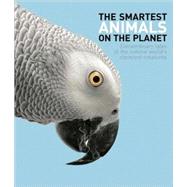
Note: Supplemental materials are not guaranteed with Rental or Used book purchases.
Purchase Benefits
What is included with this book?
| Foreword | |
| About this book | |
| Introduction | |
| Using Tools | |
| Woodpecker finches probe with sticks | |
| New Caledonian crows hook a treat | |
| Captive crows show talent for tool use | |
| Sea otters hammer their way to a meal | |
| Sea sponges provide padded protection | |
| Naked mole-rats protect their assests | |
| Why elephants use switches | |
| The wild chimp's toolkit | |
| Use of spears by wild chimpanzees | |
| Sumatrans get to grips with tools | |
| Wild gorillas stun researchers | |
| Wild capuchins adapt tool use to suit their environment | |
| Innovations with tools in captive capuchins | |
| Tool use in captive chimps | |
| Communication | |
| Dance language of honeybees | |
| Ground squirrels look out for their own | |
| Wild vervet monkey "smart" alarms | |
| Baboons: kings of expression | |
| Diana monkeys spread the news | |
| Wild chimpazees: masters of communication | |
| Signature whistles in dolphins | |
| Whales can really carry a tune | |
| Can elephants hear through their feet? | |
| Imitation and Social Learning | |
| Monkey see, monkey do? | |
| Jungle copy cats | |
| Birdbrained is best | |
| The great ape debate | |
| Ape culture? | |
| Mirror Self-Recognition | |
| Chimps use mirrors like we do - to see how they look | |
| Dolphins give themselves admiring glances | |
| It's rude to stare - gorillas don't give mirrors a second glance | |
| Elephants get the idea - with a very big mirror | |
| Numerical Abilities | |
| The case of "Clever Hans" | |
| You can count on an ant to find its way home | |
| Lions show roar talent | |
| Birds: the number crunchers | |
| Rats that can count | |
| Salamanders prefer more | |
| Young chimps learn to count | |
| Animal Language Studies | |
| Can you really teach a chimp to speak? | |
| How a chimp learned sign language | |
| Chimps and humans: do two great brains think alike? | |
| Ask a dolphin and you'll get the right answer | |
| Koko, the only gorillas to learn sign language | |
| Is he smart, or just parroting what he's heard? | |
| A young chimp keeps her answers in order | |
| An orangutan learns to sign | |
| Rocky, the sea lion with a logical approach | |
| Cooperation and Altruism | |
| "I'll scratch your back now, if you'll scratch my back later" | |
| Chimps "kiss and make up" after a fight | |
| Yawn and the world yawns with you - empathetic responses | |
| A dog's dinner is a shared affair | |
| Working together - is it teamwork or just a bunch of animals? | |
| Monkeys are quick to spot an unfair deal | |
| Glossary | |
| Index | |
| Credits | |
| Table of Contents provided by Publisher. All Rights Reserved. |
The New copy of this book will include any supplemental materials advertised. Please check the title of the book to determine if it should include any access cards, study guides, lab manuals, CDs, etc.
The Used, Rental and eBook copies of this book are not guaranteed to include any supplemental materials. Typically, only the book itself is included. This is true even if the title states it includes any access cards, study guides, lab manuals, CDs, etc.